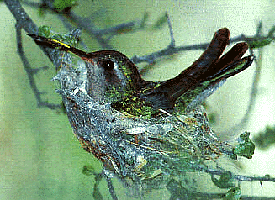The World of Hummingbirds
Hummingbirds are a family of birds that contain the smallest bird in the world. They live only in the Western Hemisphere, mostly in tropical regions. Scientists have identified more than 330 species. The first to call them Hummingbirds were the New England Colonists because of the humming sound made by their wings, which move 60 to 70 times a second in the smallest species.
Size. The tiniest of the hummingbirds is the Cuban Bee hummingbird. The bee hummingbird measures only about 2 inches long, including the bill. Another small hummingbird is the Calliope hummingbird. It lives in the western mountain regions of North America. It reaches about 3 inches in length. The Ruby-throated hummingbird grows less than 4 inches long, and it lives throughout much of eastern North America.
Only a few hummingbirds grow more than 6 inches long. The largest is the Giant hummingbird, a native of the Andes Mountains of South America. It's about 8
1/2 inches in length.Male hummingbirds are the tiniest warm-blooded animals on the planet. Females need to be a little bit bigger to be able to produce eggs. They also need to be able to share their body heat with the eggs while incubating, and to be able to share their food when feeding nestlings.
You could actually mail 9 or 10 of certain species of hummingbirds with a single stamp!
Appearance. Some hummingbirds rank among the most brightly colored birds in the world. The ruby throated hummingbird has a coat of metallic-green feathers on the upper parts of its body. The male of this species has a bright red throat, while the female's throat is white. Other hummingbird species possess glittering patches of emerald-green, deep violet, fiery red, and glowing orange feathers.
Only male hummers have the brilliant iridescent throat feathers. They use them to display to one another. Females find it attractive, and other males are repelled. Male hummers are VERY feisty and territorial and constantly bickering with one another. The red feathers are part of this territorial display. So they have two functions-attracting a female and defending their territory. The reason they seem to shine in the sun is because of brilliant colors in its feathers that are created by tiny platelets. They're much like the shimmering colors seen in a soap bubble or in a drop of oil.
When in flight hummingbirds never stop beating their wings. With their tiny size they can look like large bumblebees in the air. They fly in a direct path unless they're making a male display flight. Displaying male Ruby-throats fly in a wide arc--about 180 degrees, looking like a half-circle--swinging back and forth as if suspended at the end of a long wire. Their wings make a loud buzz at the bottom of the arc. The display of the Rufous hummer trace a steep U, climbing high, diving steeply, and making whining and popping sounds at the bottom of the dive.
Habits. Hummingbirds fly very quickly. They fly at speeds up to 25 and 30 miles an hour. During some of their incredible maneuvers they can reach speeds of over 60 miles an hour! They're great helicopters. They can fly forward, backward, upside down, right, left and even hover. Their little wings beat an average of 20-25 times per second. In some of their dives their wings beat up to 200 times per second. They're the only birds that can fly backwards.
Their long, slender bills are especially suited for sucking nectar from flowers, even the deep-throated or trumpet-shaped flowers, such as the honeysuckle and trumpet flower. The long tongue of the hummingbird is also a useful tool for obtaining food from places difficult to reach. The end of the tongue is forked, and the edges of the two parts curl together to form a double trough through which the bird laps flower nectar into its mouth.
Many people think hummers only eat nectar or the sugar-water from the feeders that are set out for them, but they also eat insects for the protein. They catch insects in the air and from the flowers as they suck the nectar. Insects form an important part of the hummingbird's diet. Sometimes it steals insects from spider webs.
Hummingbirds are BIG eaters. No animal on earth has a faster metabolism. It's roughly 100 times that of an elephant. When active, hummers must eat every ten minutes or so to support their high metabolism. They burn food so fast they often eat 1 1/2 to 3 times their body weight in food per day. In order to gather enough nectar, hummingbirds must visit hundreds of flowers every day. Just one day of cold temperatures or bad luck finding flowers can mean death. They don't feed at night so they must slow down their body functions to conserve energy. When in this rest stage they can look like they're dead because at times they don't breathe and are stiff. The body temperature can drop by 50 degrees and they can slow their heartbeat down from over 500 beats per minute to only 50 beats per minute. It can take as long as an hour to return from this torpor (an almost death like trance).
Life Cycle: Hummingbirds from temperate areas breed during the spring, while tropical species often breed in the rainy season. Male hummingbirds, along with many other animals, have what is known as a territory. A territory is simply an area that a male occupies and chases other males away from. A female hummingbird will visit a male's territory, at which time the male performs a courtship display to try to convince the female that he's the best male around. If she likes his display, she'll mate with him. If not, she moves on to another territory. Many female hummingbirds build nests high in the branches of trees (they won't use a birdhouse). The average hummers nest is only about 1 1/2" in outer diameter. Most build these nests with various materials, including shreds of bark, soft grass, and bits of plant or cattail fluff. Normally it's lined with plant down and held together with spider webs. Typically, they're covered with such substances as lichens or bits of bark. The average eggs are 1/2" long, about the size of a jellybean, and are white in coloration. The mother bird usually lays two eggs. It only takes 15 to 17 days for the eggs to hatch and the young birds start leaving the nest around three or four weeks old. The young have no feathers when born, and they can't see. They need protein, not sugar, to grow. So mother hummer spends most of her time catching small insects and spiders for them. Some species have two broods a year.
Most hummingbirds die their first year, but when they've survived a full annual cycle, their life expectancy goes up dramatically. The record age of a banded Ruby-throated hummingbird is 6 years, 11 months. The record age of a banded Rufous hummingbird is 8 years 1 month. Predators such as crows, jays, roadrunners, cats, and mice all eat baby hummers. Hummers have also been caught by dragonflies and praying mantises, caught in spiders' webs, snatched by frogs and fish, and stuck on thistles.
Attractants: Some of the many plants that can be planted to attract hummingbirds are: Abutilon, flowering maple, Aloe, American Columbine, Beard Tongue, Bottle Brush, Begonia, Cardinal Flower, Coral bells, Eucalyptus, Flowering Quince, Fuchsia, Honeysuckle, Impatiens, Lilac, Lupine, Monkey flower, Nasturtium, Orange Tree, Petunia, Pink Silk tree, Red-hot-poker, Rosemary, Scarlet Larkspur, Scarlet Runner Bean, Scarlet Sage, Shrimp-plant, Silk-oak, Trumpet Vine



